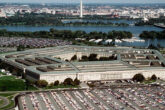March 07, 2014
2014 QDR maintains focus on climate change and operational energy
The Department of Defense released its 2014 Quadrennial Defense Review (QDR) this week. The QDR is mandated by Congress to provide information on the current state of the U.S. military and on the direction in which U.S. national defense priorities are headed. The 2010 QDR was notable for being the first such document to identify climate change as a national security threat and to lay out a comprehensive plan for improving the military’s energy security through a combination of energy efficiency initiatives and fuel diversification. The 2014 QDR presents much of the same in regards to its attention to energy and climate security issues. But it diverges significantly from its predecessor in the amount of attention it devotes to these two subjects.
The 2014 QDR is emphatic in its warnings about climate change. Much like its predecessor, the 2014 review warns that climate change poses a threat to the United States on both a micro and macro level. On the micro level, increasingly severe weather patterns and rising sea levels could impact the operational readiness of U.S. Armed Forces, as well as the resiliency of military installations within the United States and overseas. On a larger scale, climate change poses a severely destabilizing global challenge. The 2014 QDR states that climate change may exacerbate water scarcity, increase food prices, influence resource competition, and generally aggravate issues of poverty, environmental degradation, political instability, and social tensions. The QDR warns that the exacerbation of these issues in politically sensitive and fragile areas could provide the ideal breeding ground for radicalization and terrorism, as well as increase tensions between neighboring countries with shared natural resources.
Perhaps the most significant difference between the current QDR and its predecessor is the apparent decreased emphasis on energy security. This may be due to an increased focus by the Department on force size and posture and on future fiscal constraints, or a sense of reassurance derived from the massive increase in U.S. energy production and an increase in efficiency. With that said, the new review continues its predecessor’s emphasis on how the investments that the Department has made in its energy systems will improve the range, endurance, and agility of the fighting force.
With the stark climate change language in the QDR the position of the U.S. military is clear: this is a national security threat and one with which the armed forces must grapple increasingly in the future. Despite the pressing fiscal concerns of the present and that color the broader document, the 2014 QDR clarifies that the Department of Defense remains committed to mitigating the long-term environmental, economic, and political dangers that face the nation at home and abroad.
More from CNAS
-
Sharper: The Budget
The defense budget and its $715 million price tag accounts for much of the U.S. government's discretionary spending every year, but where will (and should) this money go in th...
By Anna Pederson
-
Three elements of Army’s iron triangle equally critical for United States, says defense analyst
Billy Fabian, adjunct senior fellow for the Defense Program at the Center for a New American Security and senior analyst at Govini discusses the Army's iron triangle on Govern...
By Billy Fabian
-
The Fiscal Year 2022 Defense Budget and Future Options for the Pentagon
Submitted Written Testimony I. Introduction Chairman Smith, Ranking Member Rodgers, distinguished members of the committee and staff thank you for inviting me to testify today...
By Stacie Pettyjohn
-
Risky Business: Future Strategy and Force Options for the Defense Department
To consider the next defense strategy and the tradeoffs associated with different options, we developed three possible strategies—high-end deterrence, day-to-day competition, ...
By Stacie Pettyjohn, Becca Wasser & Jennie Matuschak



